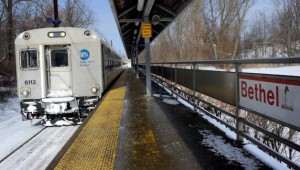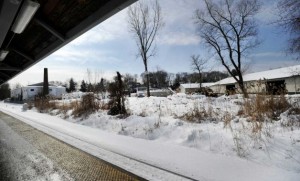BY DIRK PERREFORT
Hearst Connecticut Media
A proposal to turn outdated industrial properties near the Bethel train station into retail shops and housing has been moving forward in recent months, prompted in part by developers who are eager to update their own properties.
For more than seven years, town officials have been working on a proposed transit-oriented development district that would encompass about 133 acres surrounding the downtown train station that today is filled with warehouses and older industrial buildings.
“The goal is to enhance and integrate the area surrounding the train station with the rest of the downtown,” said Steven Palmer, the town’s planning director. “By putting more people into the downtown, we can help to strengthen the businesses that exist there today while attracting new businesses to the area.”
The idea of creating mixed-use developments around transit hubs isn’t new. In fact, the concept has been gaining steam in recent years as empty nesters look for more affordable options with nearby services. Members of the millennial generation, meanwhile, are preferring locations that are closer to transit and other services rather than being in the suburbs like past generations.
“We are seeing a whole change in lifestyle,” said First Selectman Matt Knickerbocker. “Millennials don’t want to be in the suburbs; they want to be in the middle of it all.”
Knickerbocker noted that Bethel is facing the same issues as other small and medium-sized communities that are struggling to keep their downtown vibrant.
“We also have one of the most successful malls in New England about four miles down the road,” he said, a reference to Danbury Fair.
More housing
The plan, he said, is to change the zoning regulations to allow developers to create mixed-use projects that conform with the style and character of the existing historic downtown. By adding apartments to the mix, there will be more people to support both existing businesses and new ones in the district.
That’s exactly what happened recently in Westport when Hamilton Real Estate Development redeveloped an area near the Saugatuck train station into a transit-oriented development with five shops, office space and 27 apartment units. Today the area is filled with people walking to shops, their offices, their apartments, or coming and going to the nearby train station to get to work, he said.
“There is a lot of vitality and activity going on there now,” said Sam Gault, a principal with the Hamilton company, a subsidiary of Gault Energy. “The people who live there and work there are supporting not only the new retail but also the businesses that existed before. The real beauty is that we brought a neighborhood back to Saugatuck.”

- Officials in Bethe hope to move forward with plans to create a transit-oriented development surrounding Bethel’s train station. Industrial buildings shown here next to the train station could be the future home of new retail and residential space. Photo by Carol Kaliff
At least two property owners in the proposed Bethel district are hoping to create a similar vitality downtown with projects that would fit with the town’s vision for the district.
The Development Asset Group in Danbury was recently hired by Iv Port LLC ”“ which owns property abutting the train station currently in use as a school bus depot ”“ to explore the company’s options in a new district.
“We are doing some preliminary studies to see what could work for the property,” said Rich Mancuso, owner of the Development Asset Group. “The plans are still in the conceptual stage but should fit in line with what the town has been proposing for the district.”
Mancuso said they’ve been looking at a mix of residential properties and commercial development.
“The key is really how much commercial do we want compared to residential on the site,” he said. “We don’t want to create more empty store fronts or take away from the existing downtown. We want to complement it and help strengthen the businesses that already exist there.”
An ‘oasis’
Bob Gleason, along with his partner Gary Michael, aren’t waiting for the town to get the zoning in place before moving forward with their proposals for property the developers own on Grand Street. Recently, they’ve requested an amendment and a site plan approval to construct a three-story, 26-unit luxury apartment complex on the property.
Gleason and his partner purchased the property, along with the abutting Dolan’s Plaza that fronts onto Greenwood Avenue in 2003.
“For years we’ve been struggling with what to do on the (Grand Street) property,” he said. “At one point we thought about self storage, but it’s become apparent that there is a tremendous need these days for luxury rental units. Our primary focus is to create residential units to feed not only Dolan Plaza, but the rest of the downtown as well.”
Gleason said their plans call for a pedestrian walkway that would bring tenants of the proposed apartment complex into the plaza and Greenwood Avenue, which runs through the center of the existing downtown commercial zone.
“These are the kind of apartments that will be perfect for empty nesters or young professionals who have the money to spend at local businesses,” he said. “What makes downtown Bethel so cool is that it’s an oasis. It might be tough to find, but once there all the services you need are within walking distance.”
Janice Chrzescijanek, the town’s economic development director, said they recently received a $100,000 state grant that her office applied for that will be used to further study the district.
“The first study completed in 2010 was really conceptual,” Knickerbocker said.
Financial feasibility
Palmer added that the study they hope to complete this year will go further than previous efforts by getting a better definition of what kind of density would complement the surrounding neighborhoods, as well as architectural considerations to fit with existing buildings and the creation of public spaces within the zone.
“The developers need to see what kind of regulations we’d like to put into place so they can determine if their projects are financially feasible,” he said.
One stumbling block, however, is that the town still needs another $150,000 to move forward with the study.
“The real key will be finding what sources of money might be available to make up that shortfall,” said Mike Boyle, chairman of the town’s economic development commission. “We don’t want to put together a half-baked plan.”
Boyle and other officials, however, are confident that the money can be found.
“We want something that we can move forward with this year,” he said.
Once fully funded, the study would take about three to six months to complete, Palmer said.
Both he and Knickerbocker stressed that an important part of the process to creating the zone will be public input.
“We want to hold several public hearings on the proposal to discuss the vision and see what it is that the people of Bethel want,” Knickerbocker said. “We could have more commercial opportunities near Durant while residential uses may be a better fit near Grand Street. We need to hear from the people about what they want to see.”
Hearst Connecticut Media includes four daily newspapers: Connecticut Post, Greenwich Time, The Advocate (Stamford) and The News Times (Danbury). See newstimes.com for more from this reporter.





















